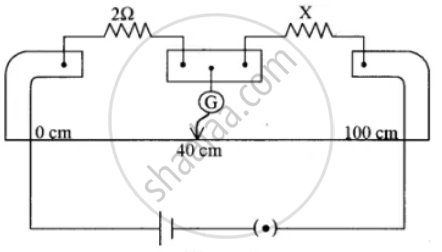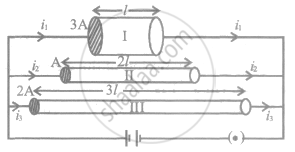Advertisements
Advertisements
Question
A wire of uniform cross-section and resistance 4 ohms is bent in the shape of square ABCD. Point A is connected to point P on DC by a wire AP of resistance 1 ohm. When a potential difference is applied between A and C, the points B and P are seen to be at the same potential. What is the resistance of the part DP?

Solution

As the points B and P are at the same potential, `1/1 = (((1 + x))/((2 + x)))/((1 - x))` ⇒ x = `(sqrt2 - 1)` ohm
APPEARS IN
RELATED QUESTIONS
Two electric bulbs P and Q have their resistances in the ratio of 1 : 2. They are connected in series across a battery. Find the ratio of the power dissipation in these bulbs
Three identical cells each of emf 2V and internal resistance 10 Ω are connected in series to form a battery. The battery is then connected to a parallel combination of two identical resistors, each of resistance 6 Ω. Find the current delivered by the battery.
Suppose you have three resistors, each of value 30 Ω. List all the different resistances you can obtain using them.
In a meter bridge circuit, resistance in the left-hand gap is 2 Ω and an unknown resistance X is in the right-hand gap as shown in the figure below. The null point is found to be 40 cm from the left end of the Wire. What resistance should be connected to X so that the new null point is 50 cm from the left end of the wire?

How much resistance should be connected to 15 Ω resistor shown in the circuit in figure below so that the points M and N are at the same potential:

If the combination is connected to a battery of emf 20 V and negligible internal resistance, determine the current through each resistor, and the total current drawn from the battery.
The figure shows three conductors I, II and III of same material, different lengths l, 2l and 3l and of different areas of cross-sections 3A, A and 2A respectively. Arrange them in the increasing order of current drawn from the battery.

How many times will the resistance of an identical conductor be increase, if the parallel resistance be change to series one?
The equivalent resistance of resistors connected in series is always ______
Eight identical cells, each of emf 2V and internal resistance 3 Ω, are connected in series to form a row. Six such rows are connected in parallel to form a battery. This battery is now connected to an external resistor R of resistance 6 Ω. Calculate:
- emf of the battery.
- internal resistance of the battery.
- current flowing through R.
